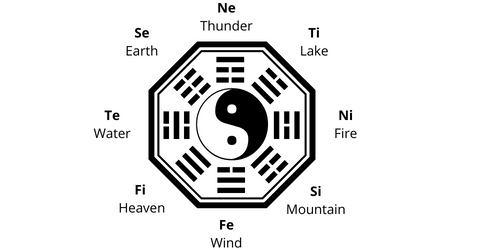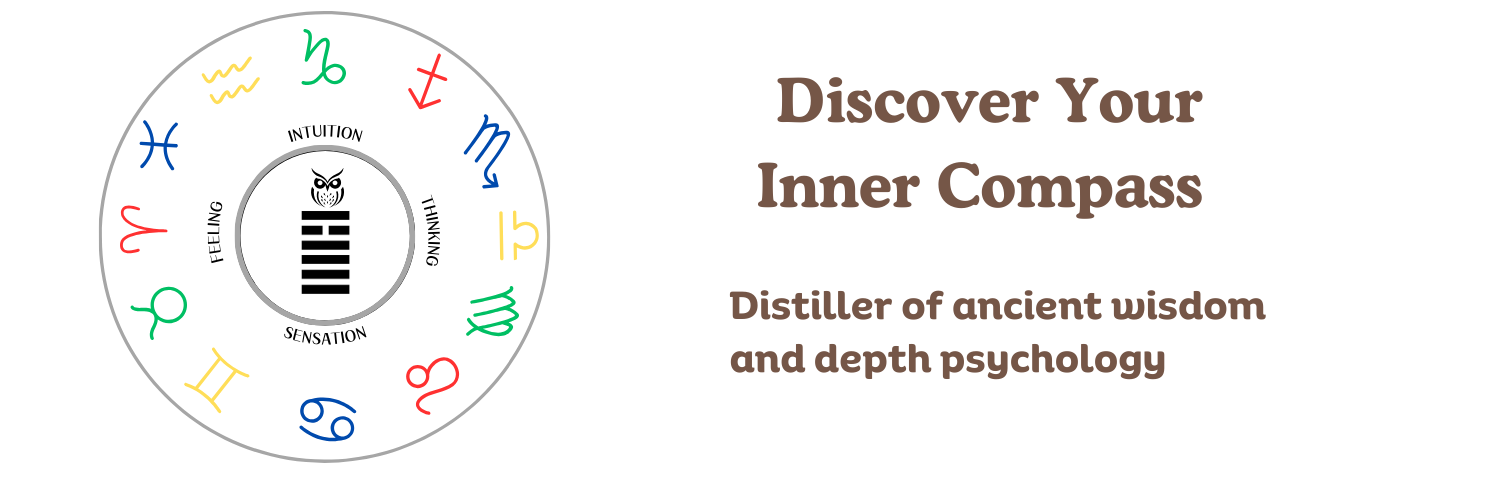I was delighted to discover archetypes for the eight functions in Michael Pierce’s book Motes and Beams: A Neo-Jungian Theory of Personality. Even better, these archetypes are from the I Ching. This is the first time I’ve seen the I Ching used in personality typology outside of Human Design. I’m also excited to see how these can be used with John Beebe’s archetypes for each role of the functions.
If you aren’t familiar with the I Ching, it is an ancient Taoist Chinese text comprised of 64 hexagrams and commentary of the meaning of the hexgram. There are eight main trigrams and a hexagram is made out of two of the eight three-line trigrams, for a total of six lines in the hexagram. Using coin tosses or yarrow stalks one can pose a question and receive an answer in the form of two hexagrams. There are 4,096 possible combinations and the answer you receive is often eerily accurate. Jung used the I Ching and was close friends with Richard Wilhelm, the first English translator of the I Ching. Jungian analyst John Beebe is an expert in the I Ching.
For the purposes of typology, Pierce focuses on the symbolism eight trigrams for the eight functions. But first, Pierce starts with the four binaries of the I Ching and compares them with the four functions The broken line (— —) represents receptivity and is yin. The unbroken line (——) represents lack of receptivity and is yang. Therefore the four binaries and the four functions are as follows:

The eight trigrams include a third line added to the above binaries. According to Pierce, a third line that is unbroken represents introversion. A third line that is broken represents extraversion. Below are the eight trigrams and the personality function that he assigns to each one. Keep in mind that the bottom line of the trigram is the first line and the foundation. The third line is the top or “roof.”


Extraverted Sensation (Se), Earth – With three broken yin lines, earth is the most receptive of the eight trigrams. Its symbol is earth because it is “plowed and sown” and receives from Heaven. According to Pierce, “Se is the function that deals with the most raw, unworked material, direct from the world.

Introverted Feeling (Fi), Heaven – With three unbroken lines, this is the most yang and unreceptive function. According to Pierce, “Fi is the made-up mind…Opinions are usually in conflict, so there is no room left for receptivity or compromise. Fi poses ideals and goals; it is the sun beyond Kant’s horizon of reason, drawing one on to greater heights (and depths). It is the expression of Man’s active hoping.”

Introverted Sensation (Si), Mountain – The unbroken line and two broken lines represent a mountain. Pierce says, “It is assertive of its own unassertiveness. While Se seeks external presence, Si seeks internal presence: it represents reality to itself in a way that is personally meaningful. Thus, like the earth, it endures all thiings; yet, unlike the earth, it remains fundamentally unchanged, except by the greatest and most sustained efforts against it.”

Extraverted Feeling (Fe), Wind – This is the opposite of the Si mountain with a broken line followed by two unbroken lines. As Pierce says, “Wind penetrates the thickest fortress walls with its infinite powers of diffusion. Just so, Fe penetrates the heart of the public – either with a breeze, or with a raging, overzealous hurricane, that can sweep the multitudes along.”

Introverted Intuition (Ni), Fire – A broken line between two unbroken lines. It is assertive in the same way fire “asserts” itself on its surroundings. Pierce says,”The seeds of fire lie in the earth (Se) and its products, dead grass and trees. Fire begins with a spark (the epiphany), and the Idea begins to smolder, dance and blaze, casting more and more light upon its environment, until it even rivals the stars. But this tremendous radiance is all dependent upon a receptive core, its eartly fuel source. It is a nothing that affects everything around it.”

Extraverted Thinking (Te), Water – An unbroken line between two broken lines. Pierce contrasts this with fire. Fire has arises upwards from an insubstantial center, where water has a substantial center, has weight, and rushes downward. Interestingly, Pierce says Te completes a cycle. “Earth (Se) sparks a fire (Ni), which rises into the heavens (Fi), from which rain waters down (Te) and runs back down into the earth (Se).” I like how he describe the motion in type.

Extraverted Intuition (Ne), Thunder – There are two broken lines with an unbroken line as the roof. Like Fire (Ni), thunder is caused by a spark or epiphany. Pierce says, “but unlike fire, which escalates, thunder is a concentrated burst of energy…The two broken lines indicate reception, namely, of static change, leading up to the consummate systole of energy (the top line) and the subsequent rousing percussion of the thunderclap. The mountain (Si) often serves as the grounding rod for this energy, because of its height. Thus, the Ne brainstorm, lancing and daggering the sky in every direction, finds its grounding in Si.

Introverted Thinking (Ti), Lake – There are two unbroken lines with a broken line as the roof. This is the opposite of Ne (Thunder) and, per Pierce, “represents resting water. … the lake is a rush of energy settling down to a halt. The water has finished running downhill for the time being, and now stands open to receive. Now, like Si, it is essentially unmoving. Ti has worked out is fundamental principles, and all that is left is to live by them.”
Putting it all together with the John Beebe archetypes
I like how visual and practical the I Ching archtypes are and am interested in how they can work with Beebe’s archetypes for the roles of each function: Hero, Parent, Child (Puer), Anima/Animus and shadow functions of Opposing Personality, Witch/Senex, Trickster, and Demon. (For fun, here is a post I did where I picked a tarot card for each of Beebe’s functions).
For example, someone with an INTJ type would have Fire as their Hero function, Water as their Parent function, Heaven as their Child function, and Earth as their anima/animus function. This provides a more complete picture of the personality and captures the movement between functions. The online typology communities often differ on how to define the eight functions, so starting with the trigrams provides a solid starting place.
I’ve thought about which astrological symbols might correlate to the eight functions, but there are only seven traditional planets and there are 12 zodiac signs, which is too many. Jung and Liz Greene say that the fire signs are intuition, the earth signs are sensation, air signs are thinking, and water signs are feeling. But that quickly falls apart when you start looking at the eight functions, which is why astrology is better for calculating temperament (here is my recent post on the melancholy temperament). You can work with both your temperament and personality type for a deeper understanding of yourself.
What do you think about the I Ching trigrams and the personality functions? Feel free to contact me if you have any comments questions.
___________
Sources:
Motes and Beams: A Neo-Jungian Theory of Personality by Michael Pierce pgs 28-32
The I Ching by Richard Wilhelm
I created the graphics in this post using stock images in Canva.
